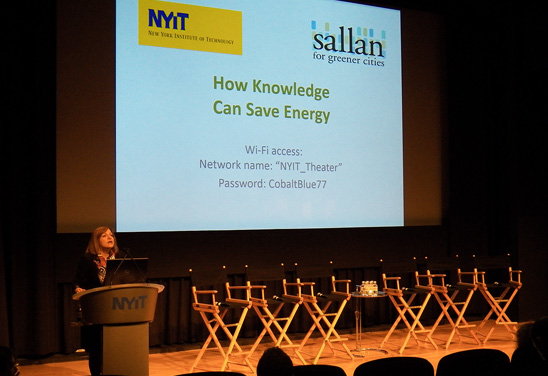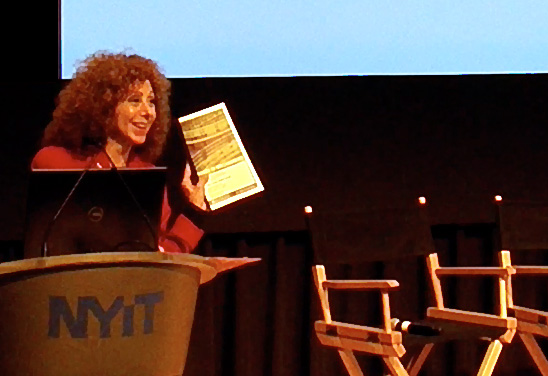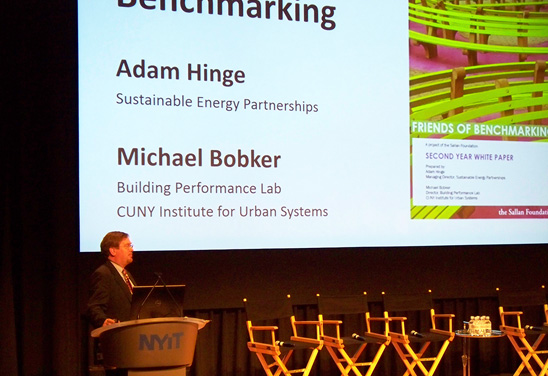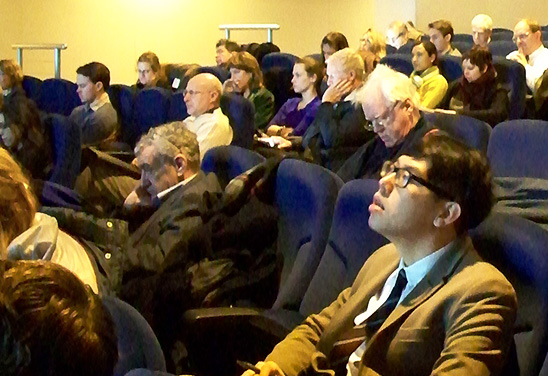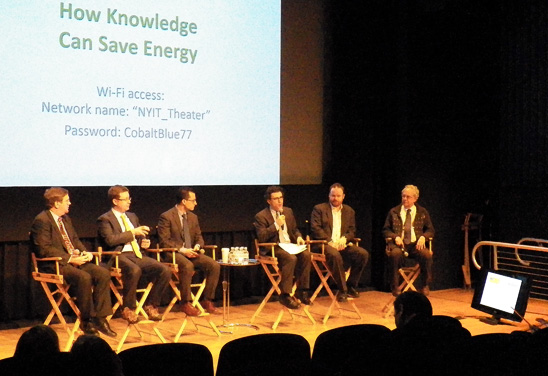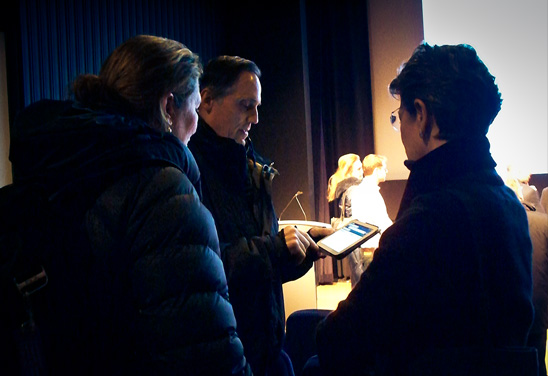
How Knowledge Can Save Power

Event Host: New York Institute of Technology

How Benchmarking Knowledge Can Save Power Event Wrap-Up
By Bridget Moffatt
How Knowledge Saves Power
New York City's Benchmarking Law, Local Law 84, provides more data on the energy performance of buildings than exists anywhere else in the country. This law created an open-to-the-public database that has served as an international and national model and is unprecedented in the amount of information collected and how we think about energy usage. Despite these obvious successes, there are still concerns of how to make this data more, accessible more accurate and, critically, how policy can make this data actionable.
Four years after the inception of Local Law 84, the Sallan Foundation convenes an expert panel to sift and sort the successes, the challenges, and the future of the law. The speakers at How Knowledge Can Save Power were keynoter Adam Hinge, Sustainable Energy Partnerships and roundtable participant Michael Bobker, Building Performance Lab, CUNY. They are the authors of the Friends of Benchmarking Second Year White Paper. The other roundtable speakers were Ari Frankel, Deutsche Asset & Wealth Management; Jonathan Flaherty, Tishman-Speyer; and Conor Laver, Bright Power. Jonathan Bowles, Center for An Urban Future served as moderator.
Nada Anid, Dean of the New York Institute of Technology School of Engineering and Computing Sciences welcomed everyone to How Knowledge Can Save Power.
Nancy Anderson, Sallan's Executive Director, spoke about the Friends of Benchmarking focus on why benchmarking needs friends, its recognition of the need for data quality improvements and more public understanding of data, in addition how to use it well.
Motivating the Friend's "Second White Paper", is Anderson's question:
Have our expectations that disclosure of benchmarking data would lead to significant building energy awareness and energy efficiency upgrades been met?
Keynoter's Second Year White Paper Findings
In answering this question Adam Hinge remarked that Local Law 84 requires compliance of nearly 22,000 buildings, encompassing half of the City's total floor space, to report their energy data usage. The amount of data collected through this law has resulted in evolving public awareness, where the once thought modern LEED buildings would represent the best energy performance, they are still outscored by prewar residential buildings and some of the City's most iconic fixtures such as the Chrysler and Empire State Buildings. Year after year more buildings are reporting in compliance with the law, which has presented us with a break down of how commercial and residential buildings consume electricity, natural gas, and fuel oil. Through this increased knowledge about how the City's buildings operate, building owners have taken steps to increase their energy efficiency.
Looking ahead, Hinge highlighted research findings pointing to the need for better evaluation of energy use in terms of a building's economic activity; the value of a letter grade to help multifamily building owners interpret their benchmarking energy use Index (EUI) score, since no percentile score is available to them; and the centrality of encouraging dialogue and collaboration around energy efficiency among owners and occupants. Last, but not least, he underscored the need to use data for public policy purposes such as identifying and supporting high-users in their efficiency efforts.
Positive Momentum
All the speakers agreed that New York City's benchmarking law, while not perfect, does create a positive momentum for improving energy performance.
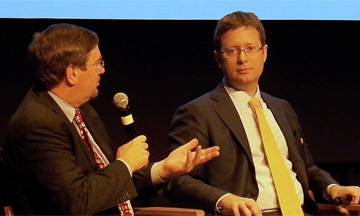
Roundtable Participants: Adam Hinge and Jonathan Flaherty
Prior to Local Law 84, energy efficiency measures were typically adopted only by the largest, most progressive companies and building owners. One of the law's major successes is the increased awareness about a property's energy performance, which is encouraging more buildings to take action. People who were initially skeptical about this data collection are coming to view it as a rational opportunity for self-improvement.
Commercial buildings have seen considerable success in benchmarking from owners perspective. The Environmental Protection Agency Energy Star rating and EUI can give owners and occupants alike information about how buildings are operating, knowing if owners are keeping the energy costs as low as possible, and therefore encourage tenants to continue renting. Local Law 84 creates an opportunity for energy discussions and allows for the consideration and possible choice of more capital energy projects.
Residential buildings make up the largest proportion of New York City buildings required to benchmark and too often are much less energy efficient than other building classes. On a more positive note, this level of energy performance presents a tremendous opportunity for improvement. Here's how: with yearly benchmarking information, multifamily family buildings can measure their energy consumption against themselves; the data allows owners and managers to see concrete results in how effective they have been from year to year in reducing their own energy efficiency usage.
Challenges Ahead
While Local Law 84 has been effective in raising awareness about how buildings and tenants consume electric and heating energy there are still many challenges.
One highlighted challenge was the use of Energy Star and Energy Use Intensity as the Benchmarking Law's chosen metrics. Energy Star ratings are based on the commercial building energy consumption survey conducted by the U.S. Department of Energy of office buildings on a national scale. Buildings in New York City, especially data center intensive office buildings and high-rise residential apartments, are difficult to compare to many buildings around the country, which raises the question of whether New York City specific benchmarks and comparisons may be more effective.
Today, under Local Law 84, residential multifamily buildings are reporting their energy performance solely using the Energy Usage Intensity metric because there is no Energy Star rating for these buildings. According to Conor Laver, the EPA has been investigating the development of a 1–100 rating for multifamily buildings and is still in the process of collecting data and developing new metrics. However there is a lack of understanding and information regarding multifamily buildings mainly because New York City's multifamily housing stock is so different than many of the nation's low-rise homes.

Roundtable Participants: Adam Hinge, Jonathan Flaherty and Ari Frankel
As Jonathan Flaherty explained, another challenge highlighted was the distinction in the role that owners and tenants play in making these energy efficiency changes. In the case of commercial buildings, which measure the whole building energy use, owners generally can only impact a modest amount of how the energy is used, once the building is open for occupancy, and it is ultimately up to the occupants to decide what kinds of equipment to purchase and how energy-intensive that equipment is. The law can be judged as a success in that it may encourage conversations between the tenants and owners on energy usage and create efficiency opportunities for all parties. But what these opportunities will be and how they will perform is speculative. This uncertainty raises the idea of developing separate rating scales for owners and occupants.
Local Law 84 has motivated action on no-cost or low cost energy efficiency projects referred to as "low hanging fruit", which often can be covered in the property's operating budget rather than become a more financially complicated capital expense. According to Jonathan Flaherty, many such projects have already been taken up in the New York City commercial sector because in these buildings, especially Class A buildings, there is staff capacity internally to complete the projects. Capital investment is now becoming what is needed to make the Class A buildings even more efficient. Within the Class B & C sectors, there are more opportunities for low hanging fruit projects because they operate on a much smaller scale, but budget and capacity constraints pose real or perceived limitations.
Future For Benchmarking Looks Bright
2014 marks the beginning of a new administration in City Hall. Starting from the current level of programmatic accomplishment, it will have opportunities to step-up momentum and continuously improve benchmarking. As such, the De Blasio administration could be ideally situated to evaluate whether New York City should pursue its own individual multifamily building rating system instead of waiting for the EPA. At the same time, adequate funding for the Mayor's Office of Long-Term Planning and Sustainability and the Department of Buildings should be budgeted to ensure that benchmarking data gathering and analysis continue.

Roundtable Participants: Conor Laver and Michael Bobker
Conor Laver cited concrete examples on how policy can help to advance the efforts of this law and he referenced the California Benchmarking Law, which requires energy performance ratings to be disclosed as part of every property transaction. The goal of this requirement is to stimulate greater awareness about energy usage for both current owners and prospective buyers.
The impacts of Local Law 84 have been clearest in the dramatic increase in awareness and the volume of information being collected. According to Michael Bobker, the future of the Benchmarking Law now rests with public policy and political action to further increase public awareness and expectations about New Yorkers' energy consumption and choices along with property owners' and occupants' ability to make this data actionable and find the value in doing so.
The panelists made it clear that Local Law 84 creates significant momentum to move New York City towards becoming a greener, more energy efficient city.
Resources & Presentations for Download
Event Co-Sponsors
- Nancy Anderson, Executive Director, the Sallan Foundation
- Marcia Bystryn, President, New York League of Conservation Voters
- Friends of Benchmarking
Event Host
- Nada Anid, Dean of the School of Engineering and Computing Sciences, NYIT
Moderator
- Jonathan Bowles, Executive Director Center for an Urban Future
Keynoter
- Adam Hinge, Sustainable Energy Partnerships
Roundtable Participants
- Michael Bobker, CIUS Building Performance Lab, Author of the Friends of Benchmarking Second Year White Paper
- Adam Hinge, Sustainable Energy Partnerships, Author of the Friends of Benchmarking Second Year White Paper — PDF of PowerPoint Presentation [1.1 MB]
- Jonathan Flaherty, Tishman-Speyer
- Ari Frankel, Deutsche Asset & Wealth Management
- Conor Laver, Bright Power — PDF of PowerPoint Presentation [379 KB]
Related Links
- Friends of Benchmarking Second Year White Paper
- ENERGY STAR Portfolio Manager
- Greener, Greater Buildings Plan LL84 How to Comply

Event Sponsor: Friends of Benchmarking
